If you’re new to RV life, a 50-amp RV plug may have some inconsistencies and questions. For instance, 110/220 or 120/240 voltages are so interchangeable in conversations that it’s difficult to know what is what and why.
Ever since Nikola Tesla and Thomas Edison got into a tiff over Direct Current and Alternating Current, electricity has been a complicated subject. Residential homes are simplified by the fact that you never have to worry too much over your 110 amp power service supplying power to your hair dryer.
RVs, however, place you in the driver’s seat regarding at least a basic understanding of how 50-amp RV plugs (or 30-amp, for that matter) correlate to 110 or 220 volts. On the bright side, that’s what we’re here for—to make the unknowable knowable and walk you through the basics of 50-amp RV plugs.
Is A 50-Amp RV Plug 110 or 220 Volts?
A 50-amp RV Plug is actually two 120V power feeds for a combination of 240V. The two power feeds in a 50-amp RV plug combine for 240V.
With 50-amps, you can power quite a lot in larger RVs, such as dual A/C units, residential refrigerators, and generally a lot more at once. That’s because there are two 120V circuits in the breaker. Devices don’t all run on the same circuit, with one A/C unit on one circuit and the residential refrigerator on the other circuit.
It’s a neat and convenient divide on the breaker that keeps you from overloading one circuit by spreading the love around. You can still overwhelm a single circuit if you’re not careful, but you should feel very comfortable in a 50-amp RV, running everything you need.
How is a 50-Amp RV Service Wired?
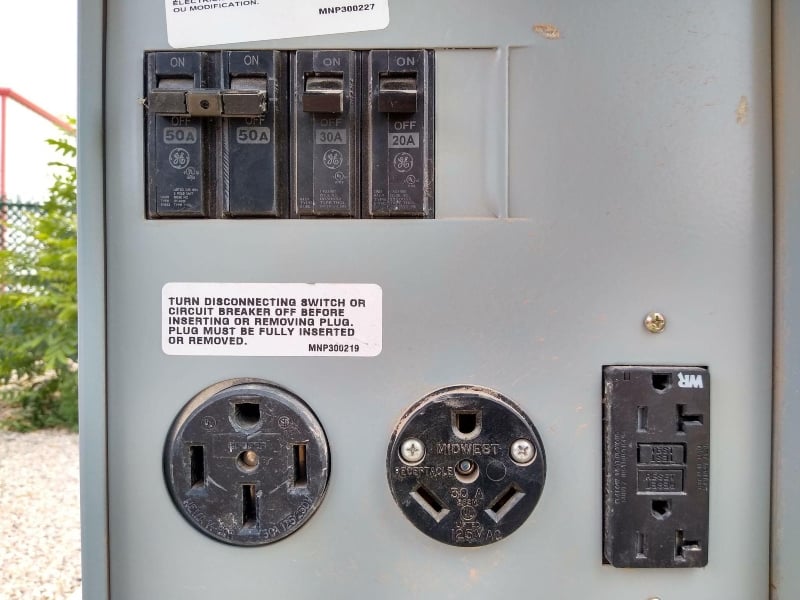
A 50-amp RV service is wired with two power feeds at 120V each, as briefly touched on above, a ground, and a neutral (a total of four prongs). You’re not getting 240V all at once, but two 120V at the same time. There are a couple of ways to recognize 50-amp versus 30-amp at the circuit breaker.
The number of prongs on your plug is an instant identification method. Four prongs on the male end equal a 50-amp plug, while three prongs are for a 30-amp plug.
The 30-amp will only have a single row of circuit breakers, while the 50-amp will have two rows of circuit breakers. As mentioned above, you’ll see two circuits when you’re plugging in a 50-amp RV. This divides your power-hungry appliances up so they aren’t all drawing on a single circuit.
It doesn’t make sense to put two A/C units on one circuit breaker. A single A/C unit in an RV typically consumes 15 amps. Two of them on one side would trip the circuit breakers on that side.
Once you break it down like that, it’s a lot simpler than it sounds in the beginning. Two circuit breakers combine for 240V and quite a lot of power.
How Much Electricity Does a 50-Amp RV Use?
A 50-amp RV has the potential to use up to 12,000 watts. That’s 12 kilowatts per hour if you max out your usage, which is hard to do without tripping the breakers. The thing is, even a 50-amp RV requires a level of restraint.
The shore power VAC service that accepts a 50-amp plug is a 50-amp split phase 120/240 VAC system. This means there will be two circuit breakers which, in theory, should supply 50-amps to both of your hot power feeds.
Typically, it doesn’t function that way. Instead, envision it as 80 amps divided into two 40-amp sections. Due to factors like a weak breaker, inadequate protection systems, or a ground fault, if you consume a continuous power load of around 40 to 45-amps on a single breaker, it’s likely to trip.
Two or three A/C units draw a lot of amps, but a 50-amp RV is designed to spread out and handle the extra load. Worst case scenario, you can run two A/C units in a three-unit RV while running other appliances. Therefore, you don’t have to worry much.
When it comes to 30-amp RVs, you have to be more careful about what’s running at the same time. You’re on a single circuit in most cases, and too much power draw can trip the breaker.
The general rule of thumb is that you can draw 80% continuous power (40-amps per circuit), though it’s probably not the best idea to have everything in your RV running all at once.
How to Plug in a 50-Amp RV to a Campsite Electric Utility
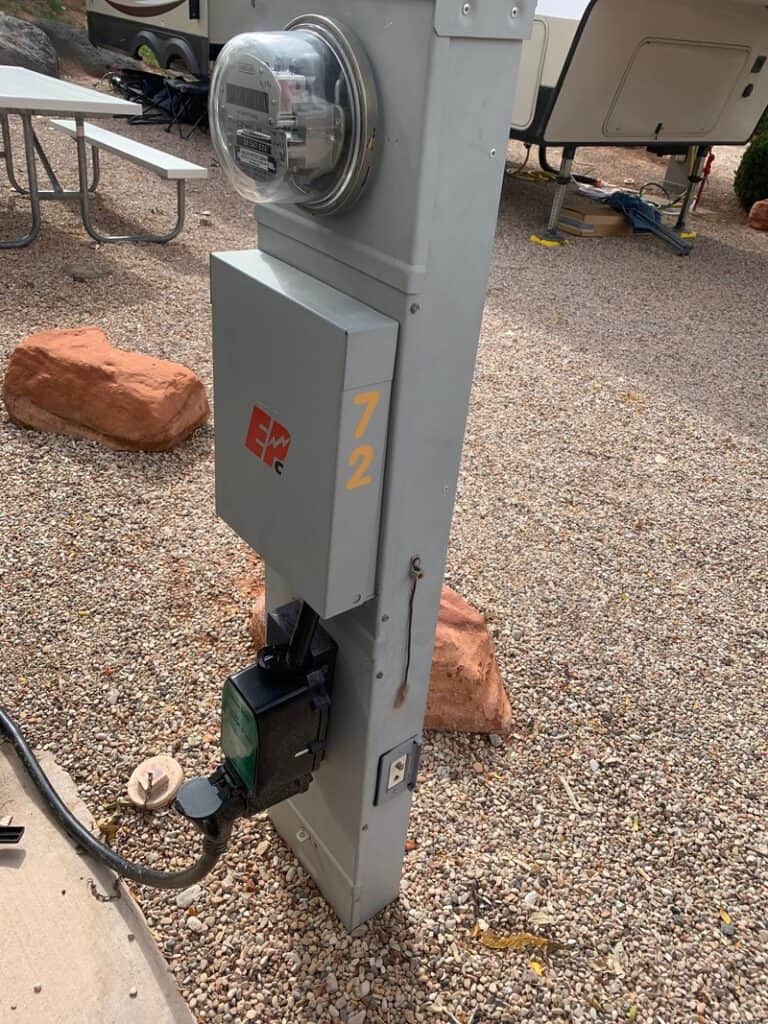
Plugging your 50-amp RV into a campsite electric utility is multifaceted, depending on where you are and what’s available. First and foremost, purchasing a surge protector is an absolute must. Don’t risk melting the insulation on your power cord lines or deep frying the electrical systems in your RV because you like to live on the edge.
Be sure to flip the main breaker off at the shore power pedestal. If you can’t locate the main breaker, flip the main breaker off on your RV’s panel. This is to prevent arcing. Arcing is when power jumps from one connection to the other, reaching up to 35,000°F temperature instantly.
It’s enough to melt the rubber and insulative properties of the plug. However, not all shore power pedestals offer 50-amp power supplies. They may only have 30-amps, and for that, you’ll need a 30 Amp to 50 Amp adapter like the one that Susan and Mike use.
Adapters typically come in two types, stubby rubber pieces, a little smaller than a fist, and a 12” cord. So, when you have the devices together, plug them into a shore power pedestal using the following steps:
- Open the shore power pedestal
- Flip off the main breaker for both circuits
- Plug in your surge protector first
- Do not plug your RV line into the surge protector yet
- Turn on the main breaker
- Make sure your surge protector gives you the go-ahead/all-clear
- Shut the main power breaker off
- Plug your RV line into the surge protector
- Turn on the main breaker(s)
Some surge protectors require anywhere between a few seconds to a few minutes to check the power supply from the pedestal before indicating the all-clear. Make sure you know your surge protector and how it functions before you plug everything in.
How to Run a 50-Amp RV on a Generator
You need the right generator to run a 50-amp RV on a generator. Not any generator will do for a 50-amp RV. We already know that a 50-amp RV can reach or even exceed 12,000 watts in power consumption. Most of your newer Class A, B, and C motorhomes come with built-in generators, so there’s no fuss when it comes to switching over to generator power.
Travel trailers and fifth-wheels aren’t in the same boat. For the most part, even knowing that you can max out at 12,000+ watts doesn’t mean you have to have a 12,000+ watt generator. In fact, many 50-amp RVs get along just fine with a 7,500 to 8,000-watt generator.
However, if you want the cream of the crop, you can always invest in a 50-amp generator like the Duramax 12000. Keep in mind more power equals more noise and weight. To make sure you’re getting clean electricity, choose one with a built-in inverter or a line conditioner.
With all of that being said, use the following steps to hook up your RV to your generator:
- Start by securing the RV power line to the RV outlet
- Do not plug into the generator yet
- Start the generator up
- Plug the RV line into the generator
- Close the circuit to put a load on the RV line
Gas generators with lower wattage that are made for a 30-amp RV will effectively supply a reduced amount of power to a 50-amp RV, but they’re still helpful when you don’t have shore power.
To get the most out of a 50-amp RV, you need the bridge adapter connecting two small generators that are designed for 30-amp RVs. Only running one generator at a time isn’t enough, so you must run both generators simultaneously to get the power supply a 50-amp RV needs to run efficiently. This is known as running two or more generators in parallel.
Parallel Kits or Companion Units
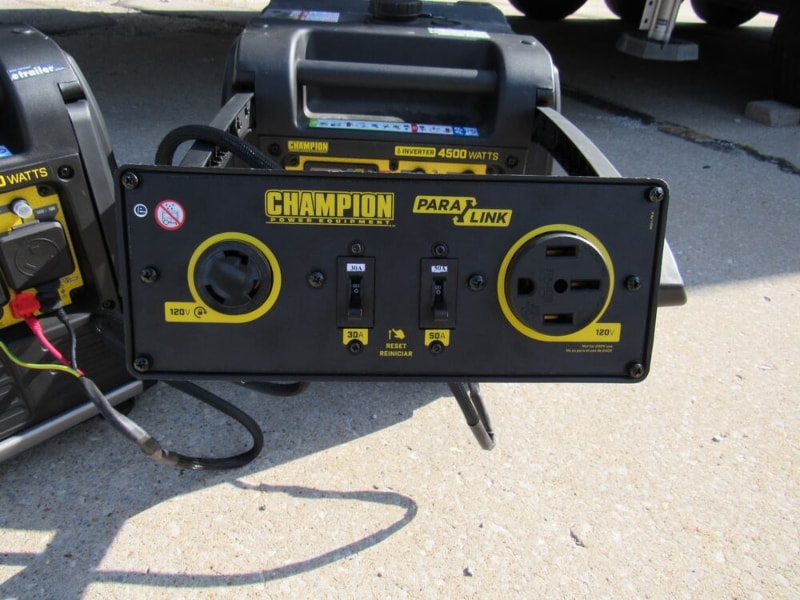
When you run generators in parallel to supply your 50-amp RV, you need a bridge device that has a 50-amp plug on it. These “bridges” between generators are known as “companion units” or “parallel kits.” The only drawback is the two generators must have identical amperage and voltage. That’s why it’s best to buy two of the same generator.
Some generators are designed to be paralleled, so pairing them up is easy. The above link is just an example, and it’s a good idea to stick with the same brand parallel kit as the generators you’re using.
3 FAQs About RVs with 50-Amp Plugs
1. Why do RVs have different RV electrical services?
RVs have different electrical services because of the power need of a 30-amp versus a 50-amp RV. The 50-amp is designed for the bigger, more luxurious feel of being at home when you aren’t. You can run pretty much whatever you need.
The 30-amp requires some cutting back and prioritization but is better off when boondocking or off the grid because it can use smaller generators. Also, smaller RVs don’t need the higher level of electricity that large luxury units require.
2. Can you run a 50-amp RV on a 110-volt service?
You can certainly run a 50-amp RV on 110V service. Of course, once you plug in, your 50-amp RV will be limited to 30-amp shore power, which is only 3,600 watts. You’ll have to skimp on some appliances and be a little more picky about what appliances you’re using at the same time.
3. What are the key differences between 30 and 50-amp electrical plugs and cords?
The primary difference between the 30 and 50-amp cords is the number of prongs. The 50-amp plugs have three prongs (Two hot wires, a ground, and a neutral). The 30-amp plugs have three prongs ( a single hot wire, a ground, and a neutral prong). Plus, the 50-amp plugs are generally bigger and heavier since they require more insulation material over four thick-gauge wires.
Final Thoughts on 50-Amp Electric Systems for RVs
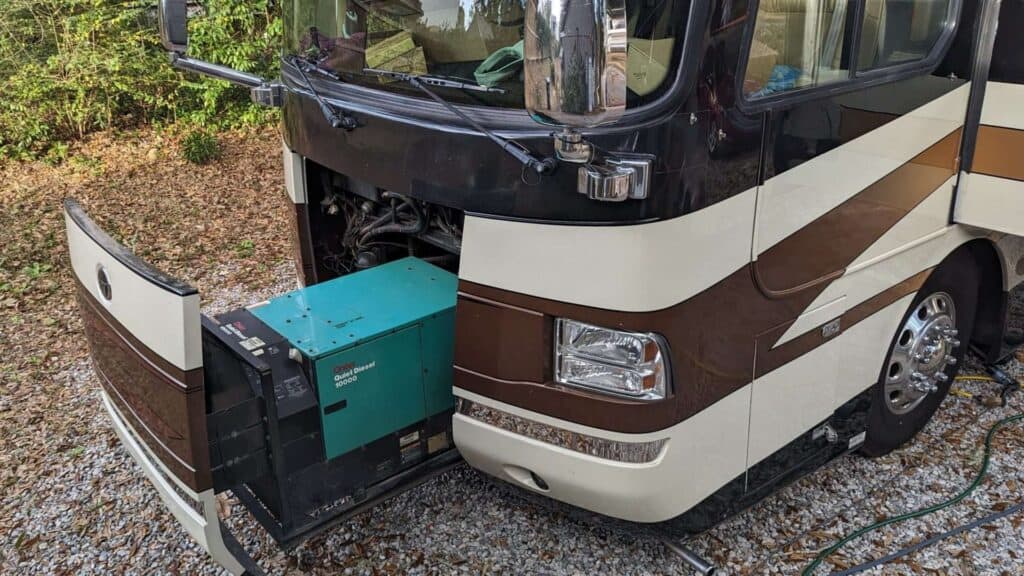
The biggest thing to take away from all this is the simple signs that help you recognize 50-amp plugs with an understanding that they are 240 (220) volts. For instance, if you see two circuit rows when you open the breaker box, you’re most likely dealing with a 50-amp system.
The 50-amp plugs feature four prongs and are bigger and heavier than their 30-amp counterparts. You can run a 50-amp plug on a 30-amp setup. To keep things safe, it may be better to rely on your RV’s house batteries if you’re not sure of the electric system you’re thinking of plugging into.
Related Reading:
1. Do RV Outlets Work on Battery Power?
2. Does an RV Fridge Work Better on Gas or Electric?
3. How Long Will an RV Battery Last
4. 7 Best Class C RVs With Washer And Dryers
About the Author:
Thomas Godwin is a full-time freelance writer with a BFA in Creative Writing, a U.S. Marine, and an avid outdoorsman.
When he’s not writing, he’s raising chickens and Appleyard ducks. Thomas also constructs teardrop campers (attempting to anyway) and kayaks the Blackwater River with his wife, two daughters, and his Dobermans.


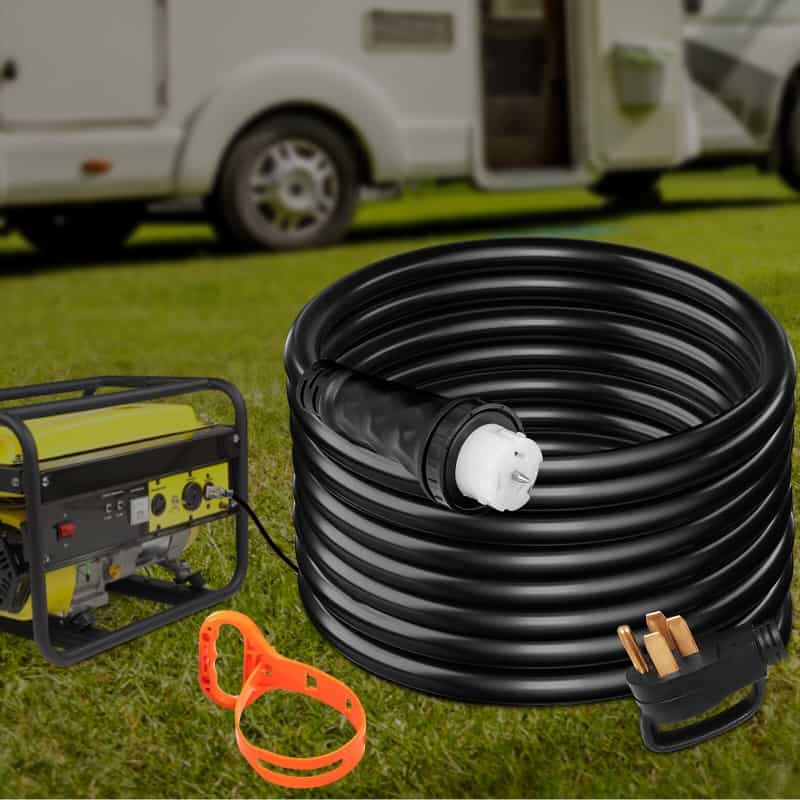
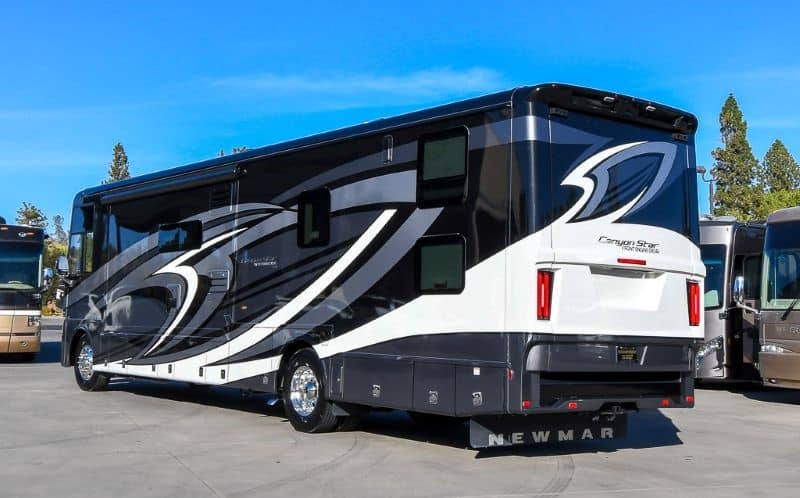
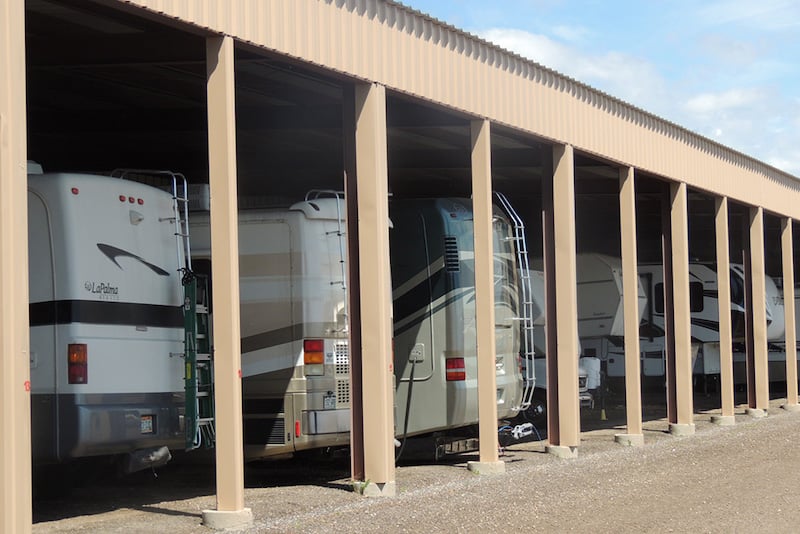
This has actually been a particularly fantastic write-up. Thanks for giving these aspects.